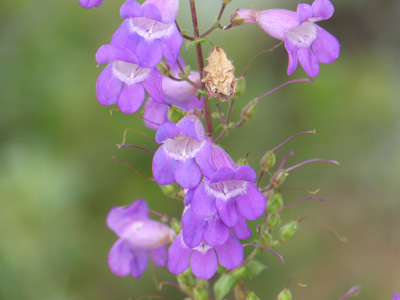Candy and Real Food — It's All Here to Enjoy!
Text and photo by Gabi McLean
(reprinted with permission from the The Paintbrush, Summer 2018, San Gabriel Mountains Chapter of the California Native Plant Society)
|
Roger Klemm calls them “eye-candy”, and he discovered – and shared on Facebook – lots of them. They are the spring flowers that have been prolific this season, especially in the areas where fire raged in the past summer or fall. We are so fortunate that we can experience many of these eye-candies in our natural gardens as well, without having to endure a fire in our garden. Some of those fire-following annuals are available in the horticultural trade, or you can grow them from seed: Arroyo and Stinging Lupine (Lupinus succulentus and L. hirsutissimus), Wild Canterbury Bells (Phacelia minor), Chia (Salvia columbaria) and Globe Gilia (Gilia capitata), and the impressive Chaparral Snapdragon (Antirrhinum multiflorum). My experience in our own garden in Covina has been that even though I put out seeds for Arroyo Lupine and Globe Gilia in earlier years, only in years after we had fires nearby, nearby meaning up to 10 miles away, have they come up. I am assuming that the winds brought just enough smoke and ash particles into our area to help with the germination of these species. Besides annuals, there are bulbs and corms that do exceptionally well after fires. Among them are Blue Dicks (Dichelostemma capitatum), Goldenstar (Bloomeria crocea), Soap Plant (Chlorogalum pomeridianum), and White Star Lily (Toxicoscordion fremontii). You might find bulbs or corms or seeds in the trade, rarely potted plants. Bulbs for our local White Fairy Lanterns (Calochortus albus), Plummer’s Mariposa Lily (Calochortus plummerae), and Yellow Mariposa Lily (Calochortus clavatus) are usually not available in the trade, so come and enjoy them in the wild. They are considered a rare find. Share information about their whereabouts only with people you know are responsible and won’t disturb, collect, or otherwise harm them or hamper their natural reproduction. For perennials, the Showy Penstemon (Penstemon spectabilis), pictured here, comes to mind. I have had no luck in other years, but this spring, we enjoyed a beautiful specimen in our garden which came up from seed. It sprouted in an odd place so I transplanted it to a new sunny spot where it now attracts hummingbirds, native bees, and admiring neighbors.
|

One shrub that we can enjoy for a few years after a fire, and in our gardens, is the Bush Poppy (Dendromecon rigida) which is readily available in our native plant nurseries. Its large yellow flowers pair nicely with its blue-green foliage and their flowering time is quite long; they love sunny slopes and are quite drought resistant.
Real food from our natural garden If you would like to share your favorite native plant recipe or your natural garden history with other CNPS members and plant lovers, please contact me at gabi.mclean@verizon.net. |
Keywords: Gabi McLean, Cliff McLean, Gabriele McLean, Clifford McLean, Nature at Hand, Gabi Horn, Gabriele Horn, Plants of the San Gabriel Mountains: Foothills and Canyon, Interpretive Guide on CD, Plants of the San Gabriel Foothills and Canyons, California native plants, Pasadena, Los Angeles, Los Angeles County, San Gabriel Valley, Southern California, Covina, natural, nature photography, photograph, environmental education, naturalist, docent, hike, hiking, CD-ROM, California native garden, gardening, flowers, wildflowers, San Gabriel Mountains, Angeles National Forest, California Native Plant Society, CNPS, Eaton Canyon Nature Center Associates, ECNCA, Arroyo Seco, invasive weeds, invasive plants